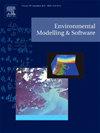遥感与流域尺度生态水文模型在密西西比河上游不同森林和农业景观中的整合
IF 4.6
2区 环境科学与生态学
Q1 COMPUTER SCIENCE, INTERDISCIPLINARY APPLICATIONS
引用次数: 0
摘要
自然流域与栅格遥感数据之间的空间错位给生态水文建模带来了挑战。为了解决这个问题,我们开发了一个针对密西西比河上游流域的综合SWAT模型,利用美国农业部划定的HUC(水文单位代码)-12个平均约100平方公里的子流域。该方法促进了蒸散发(ET)、叶面积指数(LAI)和净初级生产力(NPP)遥感数据的有效整合。为了减少预测的不确定性,土地利用类型——森林、作物和草地——根据气候和地质特征进行了聚类。经过1990年至2020年的校准和验证,该模型表现出稳健的性能,在近5000个子流域中,ET、LAI和NPP的R2和NSE值均大于0.75,百分比偏差保持在25%以下。此外,模拟的作物产量与美国农业部的观测结果非常吻合。这些发现突出了基于huc -12的模型在利用遥感数据模拟不同景观的水和碳通量方面的有效性。本文章由计算机程序翻译,如有差异,请以英文原文为准。
Integrating remote sensing data with watershed-scale ecohydrological modeling in diverse forest and agricultural landscapes of the Upper Mississippi River Basin
The spatial misalignment between natural watershed boundaries and grid-based remote sensing data poses challenges for incorporating spatially distributed observations into watershed-scale modeling frameworks. To tackle this, we developed a comprehensive SWAT model for the Upper Mississippi River Basin, utilizing USDA-delineated HUC (Hydrologic Unit Code)-12 subbasins (∼100 km2), to enable effective integration of remotely sensed evapotranspiration (ET), leaf area index (LAI), and net primary productivity (NPP). To improve accuracy, land use types—forests, crops, and grasslands—were clustered based on climatic and geological characteristics. Following calibration and validation from 1990 to 2020, the model exhibited robust performance, achieving R2 and NSE values greater than 0.75 and maintaining percent bias below 25 % for ET, LAI, and NPP across nearly 5,000 subbasins. Additionally, simulated crop yields closely matched USDA observations. These findings highlight the effectivenes of a HUC-12-based model for simulating water and carbon fluxes across diverse landscapes using remote sensing data.
求助全文
通过发布文献求助,成功后即可免费获取论文全文。
去求助
来源期刊

Environmental Modelling & Software
工程技术-工程:环境
CiteScore
9.30
自引率
8.20%
发文量
241
审稿时长
60 days
期刊介绍:
Environmental Modelling & Software publishes contributions, in the form of research articles, reviews and short communications, on recent advances in environmental modelling and/or software. The aim is to improve our capacity to represent, understand, predict or manage the behaviour of environmental systems at all practical scales, and to communicate those improvements to a wide scientific and professional audience.
 求助内容:
求助内容: 应助结果提醒方式:
应助结果提醒方式:


